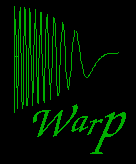This website is best viewed with the firefox browser.

This website is best viewed with the firefox browser.


Dr. ir. W. Philips
This page describes our main research results on compression and filtering of biomedical signals. Most of the work is based on the theory of approximation by warped polynomials.
In the modern hospital, the efficient storage of electronically recorded biomedical signals is an important goal. For instance, efficient coding of ECGs enables more signals to be stored on Holter-devices (which record the ECG for long periods to study relatively rare phenomena), on medical smart cards or in scientific databases. It also extends the capabilities of automatic defibrillators, which record the ECG sequence that triggered a defibrillation action.
Efficient transmission of biomedical signals over telephone lines or mobile radio is also becoming more and more important. The main applications are remote diagnosis and monitoring. Remote diagnosis is important to patients in geographically remote areas, where specialist help is not readily available. Also, transmission from ambulances saves valuable time in emergencies and allows a hospital-based physician to provide better instructions to ambulance personnel.
As telephone lines and radio channels have low capacity, they can carry only a limited number of signals (e.g., ECG leads) unless these signals are coded efficiently. For this purpose, we have developed several signal compression methods
We have developed two compression methods which enable very efficient coding of quasi-periodic pulse-like signals such as electrocardiograms (ECGs) and blood-pressure signals. Both methods divide the signals into segments corresponding to a single period. These segments are approximated by weighted sums of orthogonal base functions.
In the first method [2], the base functions are Legendre polynomials. We have shown that polynomials of relatively low degree can represent signal segments very efficiently, but only if all pulse like signal components are located on segment boundaries.
The second method [9][7] does not have this restriction, because it uses a signal adaptable base functions (instead of fixed Legendre polynomials), which are time-warped orthogonal polynomials; time-warped polynomials are polynomials in which the free variable has been replaced by a monotonically increasing function which is called a warping function. We have shown that both methods achieve much higher coding gains on ECG signals than other transform coding methods described in literature. More importantly, even at bit rates as low as 250 bits per second, the ECG waves are accurately represented. An interesting side effect is that the warped polynomial coding method behaves as an adaptive filter, which removes unwanted noise but does not distort high-frequency features such as the QRS-complexes. See the example.
Finally, we have compared the time-warped method to a wavelet technique, which represents signals by the location and amplitude of the extrema of their wavelet transforms. At the moment, only preliminary results are available [10]. These results suggest that the time-warped method allows a better signal quality at low bit rates and is robuster in the presence of noise. However, more research is needed to validate these conclusions.
Approximation by signal-adapted time-warped polynomials can be interpreted as an adaptive filter operation [9][5]. The adaptive filter is an ideal low-pass filter with a time-varying cut-off frequency which adapts to the local signal bandwidth. If the filter adapts optimally, its local cut-off frequency equals the local signal bandwidth; in that case the signal-to-noise ratio of the output signal is inversely proportional to the mean local bandwidth of the input signal [11]
In contrast, the cut-off frequency of a non-adaptive ideal low-pass filter must be higher than the maximal local signal bandwidth, if the signal is not to be distorted. As a result, the output signal-to-noise ratio of such a filter is inversely proportional to the maximum local bandwidth of the input signal, which is typically much larger than the mean local bandwidth [11]. Consequently, the adaptive filter generally performs much better.
We have used the time-warped adaptive filter to filter ECG signals, repiratory and blood pressure signals and have found that it performs much better than non-adaptive filters (See the example). The time-warped adaptive filter reacts immediately to changes in the signal's morphology and this has proved to be a major advantage over adaptive lms-type and rls-type filters.
The algorithms were programmed in C on an IBM RS/6000 workstations, but preliminary investigations have shown that they will run on inexpensive signal processors (both in floating-point and fixed-point arithmetic).
A more detailed description of the filter algorithm and the results obtained with it can be found in the report [11]. A gzipped postscript version is available here.
The postscript figure shows an original ECG signal and its reconstructions using 30 quantized OWT coefficients (OWT30) and 50 quantized DCT coefficients (DCT50), respectively. The DCT50 approximation requires 431 bits/s, while the OWT30 approximation only requires only 253 bits/s. Despite the lower bit rate, the OWT30 approximation is of much better quality.
The postscript figure shows from top to bottom